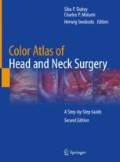Abstract
The thyroglossal tract extends from the neck to the tongue base. The skin incision is usually placed in a skin crease at the level of the cyst. An elliptical skin incision is placed encircling the opening in case of a sinus or recurrence following a previous operation. The dissection proceeds down to subplatysmal plane. The cranial and caudal flaps are raised and the strap muscles are divided in the midline. The dissection is carried down to the body of hyoid bone. A central cuff of tissue is left attached to the pedicle. The soft tissue attachments to the bone are removed in a subperiosteal plane. The skeletonized hyoid bone between the digastric slings is cut with heavy scissors. The tract with attached hyoid bone is held and traced cranially till the tongue base. Care is taken to stay in the midline to avoid injury to lingual, superior laryngeal, and hypoglossal nerves. A gloved finger pressure at the tongue base will make the resection of the tongue base and foramen cecum more precise.
The tract of the second branchial cleft anomalies starts in the tonsillar fossa, courses inferolaterally and travels superolateral to the glossopharyngeal and hypoglossal nerves. The tract courses between the external and internal carotid arteries. A fistula opens in the lower third while a cyst located in the upper third of the neck. A step-ladder incision is needed for a fistula in the lower third of the neck. The flap is raised in subplatysmal plane to the submandibular gland superiorly, posterior border of sternocleidomastoid muscle posteriorly, the clavicle inferiorly, and the strap muscles medially. The cyst and the tract freed from the surrounding structures and removed. The pharyngeal opening, if present, is removed and the gap closed in layers. Adequate measures are taken to protect the spinal accessory, vagus, and hypoglossal nerves.
Nasal dermoid presents as midline cyst, sinus, or fistula without or with intracranial extension. Complete excision must be done to avoid recurrence. Midline vertical incision, open rhinoplasty, or endoscopic approach is used depending on the length of the tract; bicoronal or subcranial approach is needed to remove the intracranial part of the tract.
Surgery is the treatment of choice for cystic hygroma. Surgery should be performed early to prevent further infiltration by the cyst. Meticulous dissection is needed to remove as much as the cyst and thereby reducing the chance of recurrence. The cystic infiltration can be suprahyoid or infrahyoid. In the former type the lingual, submandibular, and parotid gland may be involved and have to be removed. Spinal accessory, marginal mandibular, and hypoglossal nerves and sympathetic chain may be injured during surgery. Infrahyoid lesion may be closely related to the structure of the carotid sheath or even brachial plexus. It is wise to remove the huge cyst in stages to avoid damage to vital structures.
Access this chapter
Tax calculation will be finalised at checkout
Purchases are for personal use only
Author information
Authors and Affiliations
Editor information
Editors and Affiliations
Rights and permissions
Copyright information
© 2020 Springer Nature Switzerland AG
About this chapter
Cite this chapter
Dubey, S.P., Molumi, C.P., Swoboda, H. (2020). Pediatric Head and Neck Surgery. In: Dubey, S., Molumi, C., Swoboda, H. (eds) Color Atlas of Head and Neck Surgery. Springer, Cham. https://doi.org/10.1007/978-3-030-29809-8_12
Download citation
DOI: https://doi.org/10.1007/978-3-030-29809-8_12
Published:
Publisher Name: Springer, Cham
Print ISBN: 978-3-030-29808-1
Online ISBN: 978-3-030-29809-8
eBook Packages: MedicineMedicine (R0)

